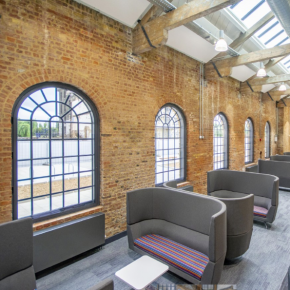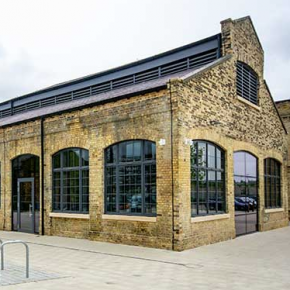
From derelict Grade II listed rail station to warm workplace thanks to Granada’s secondary glazing
As part of a £120 million redevelopment scheme at Peterborough’s Fletton Quays, Granada Glazing has designed, manufactured and installed bespoke arched secondary glazing systems to decrease the building’s carbon footprint and heat loss.
Constructed in 1845, the Grade II listed building was used as Peterborough’s first railway station and had been derelict for more than four decades.

Renovation of the Victorian railway sheds was a major part of the site’s development to create the city council’s new office, Sand Martin House.
Secondary glazing is an ideal solution to prevent heat loss, while preserving a building’s essential character. Double glazed sealed units were specified with the dual purpose of lowering heat loss and noise levels to suit its modern commercial use.

Granada’s arched heritage hinged frames supporting double glazed units were manufactured and installed to achieve an overall U-Value of 0.8W/m2K. This represents a considerable reduction in heat loss, as studies have shown a single glazed metal window has a U-Value of 5.7W/m2K.

Granada’s secondary glazing is frequently installed in listed properties, as well as buildings in conservation areas and areas with high noise pollution, where it delivers enhanced thermal and acoustic benefits.
When correctly specified and installed, secondary glazing maintains a building’s charm and character, while bringing the glazing system firmly into the 21st century.
Click here to view a video of the project.
Contact:
Granada Glazing
Campbell Way
Dinnington
Sheffield
S25 3QD
Phone: 01909 499 899
Fax: 01909 499 900
Email: info@granadaglazing.com
Twitter: @GranadaGlazing
Visit Supplier's page
Latest news

28th March 2025
Ideal Heating Commercial announces 10-year warranty on Evomax 2 boiler
Evomax 2, the UK’s number one selling commercial wall-mounted boiler from Ideal Heating Commercial, is now available with a 10-year warranty.
Posted in Articles, Building Industry News, Building Products & Structures, Building Regulations & Accreditations, Building Services, Facility Management & Building Services, Heating Systems, Controls and Management, Heating, Ventilation and Air Conditioning - HVAC, Innovations & New Products, Pipes, Pipes & Fittings, Plumbing, Retrofit & Renovation, Sustainability & Energy Efficiency, Videos
28th March 2025
FLIR Si1-LD Acoustic Imaging Camera for Compressed Air Leak Detection
FLIR, a Teledyne Technologies company, introduces the Si1-LD, an industrial acoustic imaging camera that brings faster and more accurate compressed air leak detection to those operating on a modest condition monitoring budget.
Posted in Acoustics, Noise & Vibration Control, Articles, Building Industry News, Building Products & Structures, Building Services, Facility Management & Building Services, Information Technology, Innovations & New Products, Retrofit & Renovation, Sustainability & Energy Efficiency, Thermal Imaging and Monitors
28th March 2025
LIFTEX 2025 Seminar programme announced
Registration has opened for LIFTEX 2025. Now in its 37th year, LIFTEX 2025 is the UK’s only dedicated exhibition for the lift, escalator and access industry and takes place only once every three years.
Posted in Access Control & Door Entry Systems, Accessibility, Articles, Building Industry Events, Building Industry News, Building Products & Structures, Building Regulations & Accreditations, Building Services, Exhibitions and Conferences, Facility Management & Building Services, Health & Safety, Retrofit & Renovation, Security and Fire Protection, Seminars
28th March 2025
MCRMA welcomes ArcelorMittal UK to membership
A UK division of the global steelmaking business ArcelorMittal has become the latest new member of the MCRMA, the industry association representing the metal building envelope sector.
Posted in Articles, Building Associations & Institutes, Building Industry News, Building Products & Structures, Building Systems, Cladding, Facades, Posts, Restoration & Refurbishment, Retrofit & Renovation, Roofs, Steel and Structural Frames, Walls
 Sign up:
Sign up: